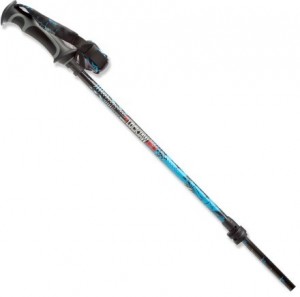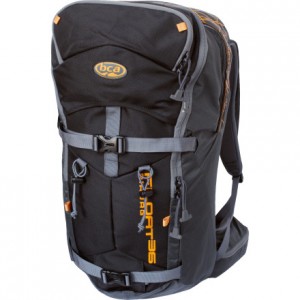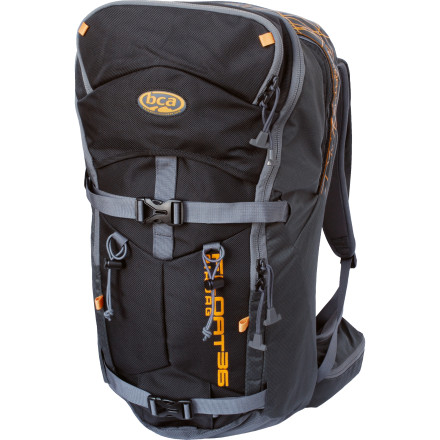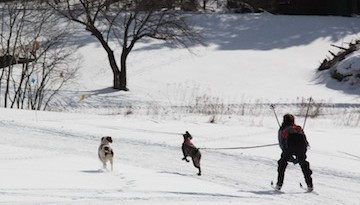K2 LockJaw Ski Pole, BCA Float 36, Long Trail Centennial Red | Gear and Beer Feb-Mar 2012
Each month we review outdoor gear and local beer. Want us to review something in particular? Send a note to gear@vtsports.com.
 Gear: K2 LockJaw Ski Poles
Gear: K2 LockJaw Ski Poles
Attempting to leave no utility left behind, this year’s K2 LockJaw is the first pole on the market to incorporate a bubble inclinometer into the handle. By laying the pole on the steep in question, you can measure the angle of most slopes, helping to determine the avalanche risk (as well as whether you should head for lines a bit less challenging). The device rides on the back of the pole, can be easily read, and is quite unobtrusive. You don’t have to take your hand out of the strap to use the inclinometer, which beats busting out a separate inclinometer from your pack. The inclinometer only measures angles from 30 to 45 degrees. To K2’s credit, they left the old backup system in place: by holding the poles perpendicular to one another and placing both tips in the snow, you can estimate the angle by demarcations on the body of the pole. Still, this method has much room for error, as you must hold one pole perfectly horizontal and the other perfectly vertical to be accurate. Another nice feature of the new LockJaws is a ruler inscribed on the pole to measure snow depth, providing a second important factor in avalanche safety. Like most other telescoping poles these days, the LockJaw can transform into a probe, as well. As for the durability of the locking mechanism and the pole markings, only time will tell.
$139.95–$179.95; Village Sports Shop, Lyndonville; Vermont Snow Wizards, Londonderry; Pinnacle Ski & Sports, Stowe
Online; REI.com
 Gear: Backcountry Access Float 36
Gear: Backcountry Access Float 36
Airbag backpack systems, first introduced around 1985, are just now becoming en vogue in the States. According to the most recent statistics from the Swiss Federal Institute for Snow and Avalanche Rescue, airbag packs can increase your chances of surviving an avalanche by four-fold or more. Backcountry Access’ website states that “an airbag is designed to keep you at or near the surface” of an avalanche, which decreases a victim’s burial time and increases the probability of survival. Domestic stats are somewhat lacking so far, but the packs probably won’t hurt your chances.
BCA’s most recent and largest in their line of packs, the Float 36, incorporates some great ideas … and also leaves some room for improvement. The pack weighs several ounces less than its 30 liter predecessor model, which is a feat in itself. However, it is by no means the lightest pack on the market (marketed at 7 pounds, 15 ounces), even on a volume-to-weight ratio basis. The upside is the heavyweight, burly, and particularly durable material used. This pack also includes nice, large zipper pulls that are easy to grasp even when wearing mittens. All the compression straps cleanly tuck away into pockets scattered about the pack—even the outer helmet sling has its own storage area. A leg strap is integrated to help prevent the pack from being ripped off you in an avalanche, although it is attached to the pack with a plastic buckle, which makes me wonder whether it’s susceptible to breakage during such a violent event. A-frame fans beware—the pack only offers a diagonal carry option. Also, there is no way to remove the airbag or compressor system from the pack, relegating it to pretty much a sole-purpose use. The interior does have sleeves for organizing safety gear, but even the width of BCA’s own shovel barely fits. Otherwise the space is quite ample, fitting goggles (in their own fleece-lined pocket), extra layers, a probe, water bladder, food items, and kneepads. There is a lumbar back-panel entry, as well, though I think this just adds unnecessary weight to the unit. Finally, while all these packs are quite pricey, BCA provides the most reasonably priced one for its size. Probably worth a few hundred bucks for a shot at not being buried alive.
$785; Backcountry dealers: West Hill Shop, Putney; Equipe Sports, Rawsonville; First Trax, Montgomery.
Online; Backcountry.com
 Beer: Long Trail Centennial Red (Brewmaster Series)
Beer: Long Trail Centennial Red (Brewmaster Series)
Like many redheads, this one’s got some spunk! Pouring a deep auburn out of the bottle yields a very minimal head that is lacey and creamy at the same time. Caramel and citrus infused with a touch of pine permeate the nose, which seems very nice and reminiscent of the holidays. Similarly, the taste starts with a hint of sweet clementine and then provides dulce de leche sandwiched between oat crackers or savory biscuits. With a fairly medium body, it’s very smooth and easy to drink, with little to no finish taste at the back of the palate. While not the most remarkable beer I’ve ever imbibed, it does provide a really nice seasonal essence that I enjoyed quite a bit … enough to drink a 22-ounce in a pretty short sitting, anyway. It’s getting toward the end of this beer’s release, but you should be able to find it in specialty beer shops for a few more weeks.



